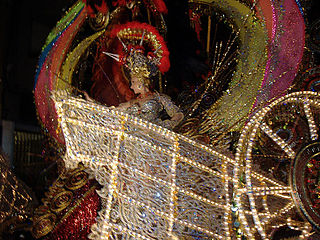
Carnival or Shrovetide is a Christian festive season that occurs before Lent, consisting of Quinquagesima or Shrove Sunday, Shrove Monday, and Shrove Tuesday or Mardi Gras.

Many aspects of Colombian culture can be traced back to the early culture of Spain of the 16th century and its collision with Colombia's native civilizations. The Spanish brought Catholicism, the feudal encomienda system, and a caste system that favored European descendants.

Pasto, officially San Juan de Pasto, is the capital of the department of Nariño, in southern Colombia. Pasto was founded in 1537 and named after indigenous people of the area. In the 2018 census, the municipality had a population of 392,930. Pasto is located in the Atriz Valley on the Andes cordillera, at the foot of the Galeras volcano.

Manizales is a city in central Colombia. It is the capital of the Department of Caldas, and lies near the Nevado del Ruiz volcano.

Bogotá's Carnival or Carnival of Bogotá is celebrated in Bogotá every year on August 5 and August 6 for the city's anniversary of its Hispanic foundation. Most of the cultural events take place in the heart of Parque Metropolitano Simón Bolívar The festivities also include pre-carnival celebrations during the month of July. One of the main objectives of the carnival is to promote and encourage the cultural and musical diversity of Colombia.

Blacks and Whites' Carnival, is the largest and most important festival in southern Colombia. Although its geographical location belongs to the city of Pasto, it has been adopted by other municipalities in Nariño and southwestern Colombia. It is celebrated every year in 2–7 January and attracts a considerable number of Colombian and foreign tourists.

The Barranquilla Carnival is one of Colombia's most important folkloric celebrations, and one of the biggest carnivals in the world. The carnival has traditions that date back to the 19th century. Four days before Lent, Barranquilla decks itself out to receive national and foreign tourists to join together with the city's inhabitants to enjoy four days of intense festivities. During the carnival, Barranquilla's normal activities are put aside as the city gets busy with street dances, musical and masquerade parades. The Carnival Of Barranquilla includes dances such as the Spanish paleo, African Congo, and indigenous mice y mica's. Many styles of Colombian music are also performed, most prominently cumbia, and instruments include drums and wind ensembles. The Carnival of Barranquilla was proclaimed a Cultural Masterpiece of the Nation by Colombia's National Congress in 2002. Also the UNESCO, in Paris on November 7, 2003, declared it one of the Masterpieces of the Oral and Intangible Heritage of Humanity, and it was during Olga Lucia Rodriquez Carnival Queen year.

Cali Fair is an cultural event held in Cali, Colombia from December 25 to December 30. It is a celebration of the region's cultural identity, famous for the Salsa marathon, horse riding parades and dance parties.
This page is a glossary of Colombian music.

Riosucio is a town and municipality in the department of Caldas in Colombia. It is best known for its biennial carnival, officially called the Carnival of Riosucio but commonly known by its former name of the "Carnival of the Devil", and is one of the biggest and most popular carnivals in Colombia. Located along the Colombian coffee growing axis, the municipality was made part of the "Coffee Cultural Landscape" UNESCO World Heritage Site in 2011.

The contribution of travel and tourism to GDP was US$5,880.3bn in 2016. Tourism generated 556,135 jobs in 2016. Foreign tourist visits were predicted to have risen from 0.6 million in 2007 to 4 million in 2017. Responsible tourism became a peremptory need for Colombia because it minimizes negative social, economic and environmental impacts and makes positive contributions to the conservation of natural and cultural heritage.

The Carnival of Santa Cruz de Tenerife is held each February–March –depending on the year– in Santa Cruz de Tenerife, the capital of the largest island of the Canary Islands, Spain and attracts people from all over the world.

The Carnaval de Ponce, officially Carnaval Ponceño, is an annual celebration of the Carnival holiday held in Ponce, Puerto Rico. The celebration lasts one week, and like most observations of the holiday ends on Fat Tuesday. Thus, like the Carnival holiday in general, it is usually held in February and or March. It dates back to 1858. Some authorities, such as the Smithsonian Institution, believe the Ponce Carnaval can be traced to as far back as 250 years ago. The Carnaval coincides with the Mardi Gras of New Orleans, the Carnival of Venice, and Rio de Janeiro's Carnival and hundreds of other places that observe this holiday around the world. The estimated attendance is 100,000. Scenes of the 2011 Carnaval Ponceño were featured in the Travel Channel on 7 August 2011.

Feria del Sol, or Carnaval Taurino de America, is an international cultural festival held in the city of Mérida, Venezuela every February of the year. The Feria festival is held alongside the carnival feast. The festival includes bull competitions, cultural expositions, commercial and zootechnic expositions, concerts, parades, sports, and a voting competition for La Reina Del Sol.

The "Festival del Bambuco en San Juan y San Pedro", formerly called "Festival Folclórico y Reinado Nacional del Bambuco" or Bambuco Pageant and Folkloric Festival in English, is the largest and most important celebration in Huila Department and one of the most important celebrations in southern Colombia. It is celebrated annually in the city of Neiva during the Feast of Saints Peter and Paul and attracts a considerable number of Colombian and foreign tourists. The festival was declared National Cultural heritage by the Congress of Colombia in 2006.
Carnival in Mexico is celebrated by about 225 communities in various ways, with the largest and best known modern celebrations occurring in Mazatlán and the city of Veracruz.

Cumbia is a folkloric genre and dance from Colombia.


















